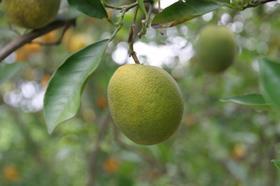
University of Florida (UF) scientists think a group of hormones may eventually help growers battle the deadly citrus greening disease (HLB), but still want to study them before recommending growers use the chemical.
Fernando Alferez, an assistant professor of horticultural sciences at the UF Institute of Food and Agricultural Sciences (IFAS), leads a team of researchers studying the effects of Homobrassinolides (HBr), a type of plant hormone, on greening-infected citrus trees.
“In preliminary research, we have been able to see some positive effects of HBr on citrus tree health and fruit production,” said Alferez, a faculty member at the UF/IFAS Southwest Florida Research and Education Center in Immokalee, Florida.
Although HBr is commercially available and can be used for Florida citrus, UF/IFAS researchers are still researching its impact on citrus greening before making a final recommendation to growers.
But early research shows that with the hormone, fruit is maturing faster and is 20 per cent heavier, Alferez said. The hormone also helps reduce the number of oranges that drop from the trees - In treated trees, scientists have seen 15 to 20 per cent more fruit per tree.
“This is something growers could experiment with now,” said Michael Rogers, director of the UF/IFAS Citrus Research and Education Center in Lake Alfred, Florida.
Greening, or Huanglongbing (HLB) is caused by the bacterium Candidatus liberibacter asiaticus. So far, the hormone has not reduced bacteria in the citrus trees, Alferez said, but scientists have seen indicators of better tree health, such as more chlorophyll, in their preliminary research, suggesting that the treatment can make citrus trees more tolerant to greening.
“That, in turn, may result in better overall tree health and increased yields,” Alferez said. “For these reasons, this season we will explore the potential of HBr as a new managerial tool to improve tree health and manage new leaves and blooming.”
Alferez and two other UF/IFAS researchers received funding from the state legislature-funded Citrus Initiative, to explore how well HBr would work on trees affected by citrus greening.
Tripti Vashisth and Christopher Vincent, assistant professors of horticultural sciences at the UF/IFAS Citrus Research and Education Center (CREC) in Lake Alfred are teaming up with Alferez on the research.
The UF/IFAS hormone research started during the 2017/18 growing season, when scientists set out to assess the effect of HBr on citrus tree health, fruit yield and quality. They also wanted to know if it would impact the bacterium that causes greening.
The researchers tested experimental groves at CREC and at the Southwest Florida REC, ensuring results were applicable statewide. They studied the same varieties, layout and number of trees at each research center, Alferez said.
If scientists can determine how to correctly time the application of the compound, their findings may help induce blooming at the desired time.
“In addition, accelerating peel color opens interesting possibilities to manage fruit maturation,” Alferez said. “It is easy to see that this could be a tool for fresh fruit production as well, where peel colour is of great importance.”
The faster the fruit turns the right color, the earlier it can hit the market, he said.
“You can satisfy demand for mature fruit earlier at a moment in which, in normal conditions, there would not be mature fruit available,” Alferez said. “In short, you may advance the harvesting season.”



